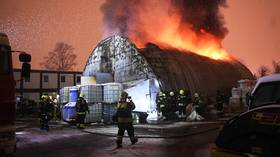Hidden epidemic killing more in Russia than anywhere else in world

More Russians die in fires than in any other country in the world, the nation’s top emergency services official has said, blaming the dubious distinction on a lack of regulations.
“A new fire starts every minute in Russia, and every hour, someone dies and someone is injured,” Alexander Chupriyan, interim minister of emergency situations, told business daily RBK in an interview published Friday. “We’re in first place for fire deaths per capita, with 5.8 per 100,000. That’s higher than other post-Soviet countries, and also higher than in developed nations like Germany or the US.”
The minister called for stricter fire-prevention regulations to avert industrial accidents, and rejected the idea that such measures would be too expensive for businesses, pointing out that the human cost is already enormous. “If norms and regulations were implemented, then people wouldn’t die,” he said. “There would be fewer losses if evacuation routes weren’t blocked, if signs were turned on, if smoke filtration worked, and so on. Right now it’s still easier for a business to buy off a regulatory agency than implement the requirements.”
The comments come just weeks after an explosion killed more than 50 people, including six rescue workers, at the Listvyazhnaya coal mine in the Kemerovo region of southern Siberia. This week, law enforcement arrested several managers and one of the mine’s owners on charges of failing to implement safety features that could have prevented the tragedy.
In 2016, a series of explosions killed 36 people at the Vorkuta mine in Russia’s Komi Republic, and in 2010, an explosion at the Raspadskaya mine in Kemerovo killed 66 workers. In all three cases, investigators determined that the explosions had been caused by methane leaks.
“Where technological processes are associated with risk, every single person involved must have ironclad discipline,” Chupriyan said. “There must be constant monitoring of the concentration of methane in coal mines, not just the appearance of such monitoring.”














